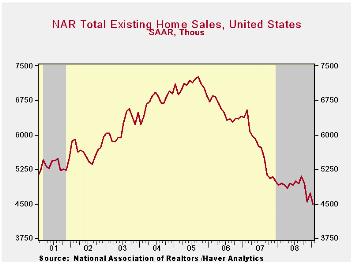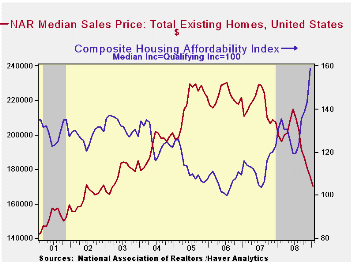 Global| Feb 25 2009
Global| Feb 25 2009January U.S. Existing Home Sales & Prices Fell
by:Tom Moeller
|in:Economy in Brief
Summary
Any prior indication that home sales were stabilizing should be dismissed. According to the National Association of Realtors, sales of existing homes fell 5.3% last month to 4.490M after an unrevised December rise of 4.4%. Consensus [...]

Any prior indication that home sales were stabilizing should be dismissed. According to the National Association of Realtors, sales of existing homes fell 5.3% last month to 4.490M after an unrevised December rise of 4.4%. Consensus expectations had been for January sales of 4.79M homes. Total sales include sales of condos and co-ops.
For existing single-family homes alone sales reversed all of their December rise with a 4.7% decline to 4,050 million units, the lowest level since July 1997. (These data have a longer history than the total series).
The weakness in sales continued to lower pricing power. Median home prices plumbed a new cycle low with a 3.1% month-to-month (NSA) decline. It was the seventh consecutive monthly drop and it lowered prices by 14.8% from January of 2008. Prices have fallen 25.8% since their peak in June 2005.
The number of unsold homes (condos & single-family) on the market dropped 2.7% (-13.5% y/y) as sellers pulled homes for sale. At the current sales rate there was a 9.6 months' supply on the market which was near the lowest since 2007. For single-family homes the inventory was unchanged after a sharp December decline and at the current sales rate there was a 9.2 month's supply, near the lowest since 2007.
By region, home sales in the Northeast collapsed 14.7% m/m to lower them by nearly one quarter from the year ago level. Single family home sales here were at their lowest since 1991, off 46% from the 2007 peak. Sales in the South followed with a 5.7% decline which reversed the December gain. Single family sales were at their lowest since early 1998. Sales in the Midwest also reversed the December gain with a 5.7% decline to the lowest level since 1997. Only sales in the West held up. They were unchanged last month from December and they were up by 29% from the year ago level.
Declines in home prices and lower interest rates have gone a long way to increase the affordability of an existing home. The measure rose to a record high for the series which dates back to 1971.
The data on existing home sales, prices and affordability can be found in Haver's USECON database. The regional price, affordability and inventory data is available in the REALTOR database.
Commitment Versus Discretion in Monetary Policy from the Federal Reserve Bank of Philadelphia is available here.
| Existing Home Sales (Thous) | January | y/y % | December | January '08 | 2008 | 2007 | 2006 |
|---|---|---|---|---|---|---|---|
| Total | 4,490 | -8.6 | 4,740 | 4,910 | 4,893 | 5,674 | 6,516 |
| Northeast | 640 | -23.8 | 750 | 840 | 845 | 1,010 | 1,093 |
| Midwest | 1,000 | -16.7 | 1,060 | 1,200 | 1,130 | 1,331 | 1,494 |
| South | 1,640 | -15.9 | 1,740 | 1,950 | 1,860 | 2,243 | 2,577 |
| West | 1,200 | 29.0 | 1,200 | 930 | 1,064 | 1,095 | 1,357 |
| Single-Family | 4,050 | -7.1 | 4,250 | 4,360 | 4,341 | 4,960 | 5,712 |
| Median Price, Total, $ | 170,300 | -14.8 | 175,700 | 199,800 | 197,250 | 216,633 | 222,042++ |
Tom Moeller
AuthorMore in Author Profile »Prior to joining Haver Analytics in 2000, Mr. Moeller worked as the Economist at Chancellor Capital Management from 1985 to 1999. There, he developed comprehensive economic forecasts and interpreted economic data for equity and fixed income portfolio managers. Also at Chancellor, Mr. Moeller worked as an equity analyst and was responsible for researching and rating companies in the economically sensitive automobile and housing industries for investment in Chancellor’s equity portfolio. Prior to joining Chancellor, Mr. Moeller was an Economist at Citibank from 1979 to 1984. He also analyzed pricing behavior in the metals industry for the Council on Wage and Price Stability in Washington, D.C. In 1999, Mr. Moeller received the award for most accurate forecast from the Forecasters' Club of New York. From 1990 to 1992 he was President of the New York Association for Business Economists. Mr. Moeller earned an M.B.A. in Finance from Fordham University, where he graduated in 1987. He holds a Bachelor of Arts in Economics from George Washington University.






